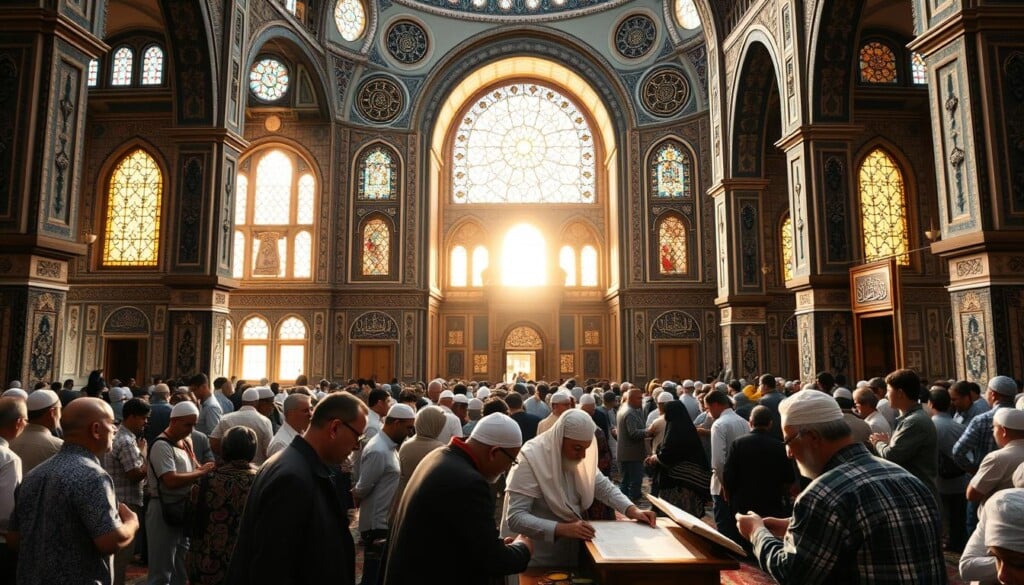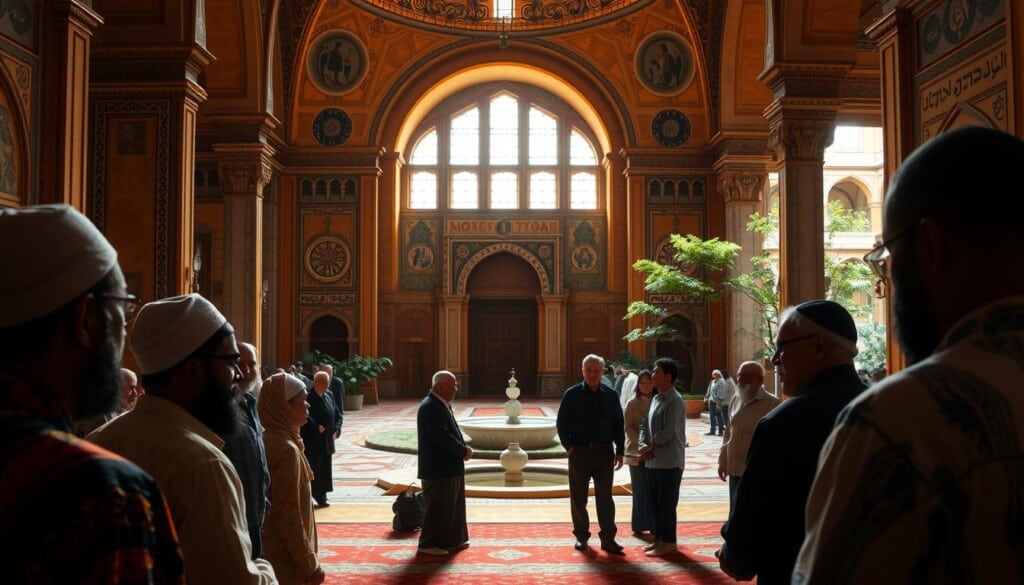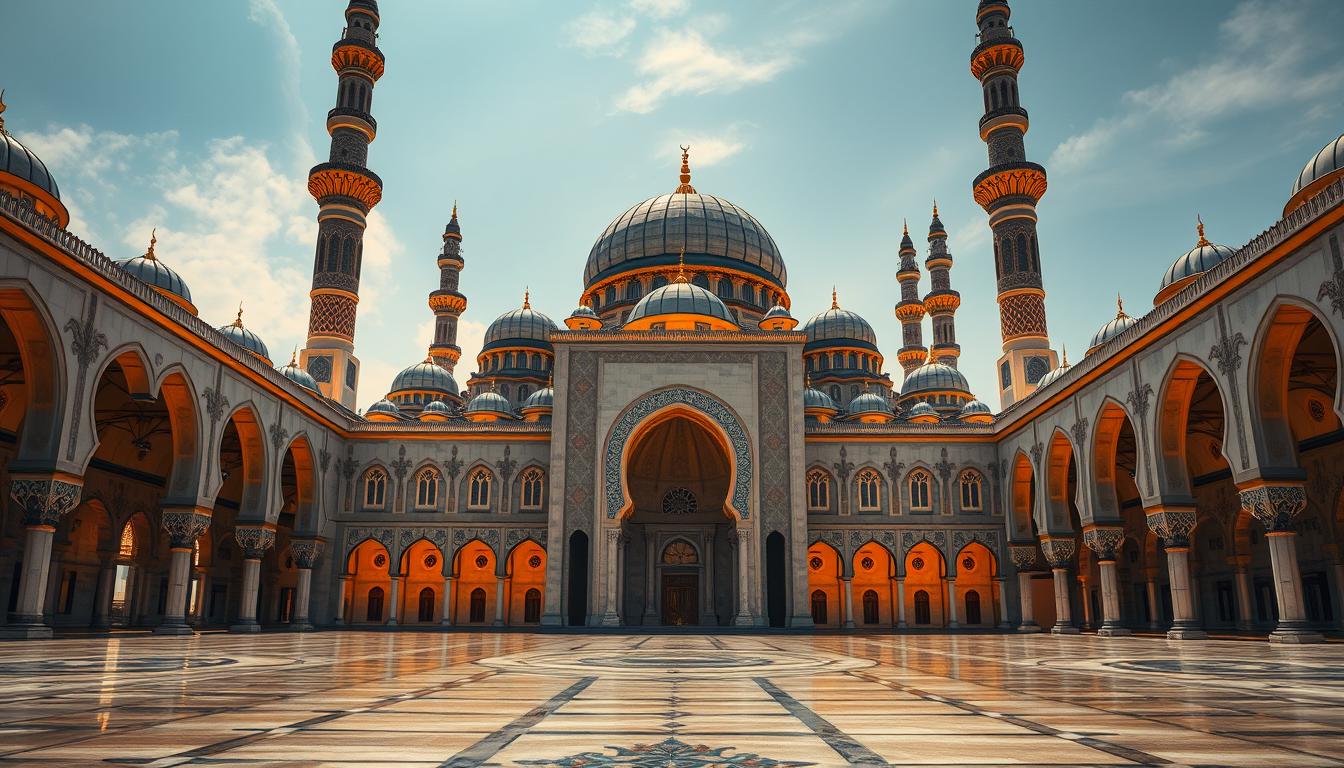Have you ever thought about how mosques shape a city’s skyline? They hold centuries of Islamic history and culture. These Islamic places of worship are more than buildings; they are a blend of faith, art, and community.
Each mosque’s design, from its grand domes to the detailed patterns on its walls, shows off rich artistic traditions. These traditions vary across cultures, adding to their spiritual value.
Mosques are key places for learning and coming together. They connect communities and help build a strong cultural identity. By looking into the architecture and history of these sacred spaces, we learn more about religious devotion and human experiences.
Key Takeaways
- Mosques embody both spiritual and cultural significance.
- Architectural styles reflect regional diversity and artistic traditions.
- Mosques are community hubs that promote local identity.
- Exploring their history reveals the intertwined relationship between faith and art.
- Each mosque’s design contributes to a deeper understanding of Islamic heritage.
Understanding the Significance of Mosques
Mosques are key parts of Islamic culture, meeting spiritual and social needs. They are places for prayer and reflection, strengthening the Muslim community’s faith. Mosques are more than buildings; they represent Islamic values and beliefs.
The Role of Mosques in Islamic Culture
In Islamic culture, mosques are at the heart of the community’s spiritual life. They host congregational prayers, like on Fridays, which are very important. This brings worshippers together, creating a sense of unity.
Mosques are also places of learning. They share religious and cultural teachings, helping to educate the community.
Architectural Styles of Mosques
Mosque architecture is diverse, influenced by local traditions and history. Features like domes, high minarets, and ornate calligraphy show the artistry in these buildings. Each mosque’s design reflects its region’s style, adding to the beauty of mosque architecture.
Mosques as Community Hubs
Mosques are more than just places of worship; they are community centers. They host cultural events, educational programs, and social gatherings. This brings together Muslims and non-Muslims, promoting understanding.
The Islamic Society of Boston Cultural Center is a great example. It organizes interfaith events, aiming to bridge cultural gaps and foster mutual respect.
Iconic Mosques Around the World
Iconic mosques have been symbols of faith and architectural wonder for centuries. This section highlights three standout examples: Al-Masjid an-Nabawi, the Great Mosque of Samarra, and the Blue Mosque. Each mosque showcases unique aspects of mosque architecture and their cultural importance.
Al-Masjid an-Nabawi: A Historical Landmark
Located in Medina, Saudi Arabia, Al-Masjid an-Nabawi is one of the largest mosques and a historical gem. It is the burial site of Prophet Muhammad, making it spiritually significant. Its dome and large courtyard are classic examples of mosque architecture, drawing millions each year.
The Great Mosque of Samarra: Unique Architecture
The Great Mosque of Samarra in Iraq is known for its innovative design. Its Malwiya Tower, a spiral minaret, is a marvel. This mosque reflects early Islamic civilization’s architectural breakthroughs. Its design and size make it a top iconic mosque.
The Blue Mosque: A Gem in Istanbul
The Blue Mosque, or Sultan Ahmed Mosque, in Istanbul, Turkey, is celebrated for its symmetry and blue Iznik tiles. It’s a masterpiece of Ottoman architecture, blending art and function. Its grandeur inspires awe in all who visit, making it a cultural treasure.
![]()
The Architectural Beauty of Local Mosques
Local mosques in the United States blend traditional mosque architecture with modern design. These places are not just for worship but also cultural landmarks in their communities. The detailed designs reflect Islamic heritage while embracing today’s aesthetics.
Notable Designs in the United States
The Islamic Center of America in Dearborn, Michigan, is a prime example. It combines traditional and modern styles beautifully. Its minaret and large prayer hall welcome everyone, celebrating Islamic values.
The Islamic Cultural Center of New York also shows mosque architecture’s evolution. It uses glass and open spaces, connecting worshippers to the city around them.
The Evolution of Mosque Architecture in America
In recent decades, mosque designs in the U.S. have changed a lot. They now reflect American culture, showing the Muslim community’s growth. Mosques now use sustainable materials, showing a commitment to the environment and Islamic values.
As more mosques appear, they shape America’s landscape. They are important for gathering and cultural expression.
How Mosques Foster Community Engagement
Mosques are key places for community engagement. They help build a strong social and educational base in their areas. Islamic centers offer many educational programs for both locals and the public.
These programs include Arabic classes, workshops on Islamic teachings, and interfaith dialogue seminars. They help people learn and build relationships with others from different backgrounds. This leads to better understanding and cooperation among all.
Educational Programs and Activities
Mosques play a big role in education and skill development. They have programs for people of all ages. This makes it easy for families to learn more about Islam and its culture.
They host events like community lectures and youth mentorship programs. These activities help mosques become centers of learning and unity.
Social Services Offered by Mosques
Mosques also provide important social services. Places like the Dar Al-Hijrah Islamic Center run food banks and health screenings. Their goal is to help those in need and support the community.
These services meet immediate needs and bring people together. They show mosques as essential places for community service.

Visiting a Mosque: Etiquette and Guidelines
Visiting mosques can be a deeply enriching experience. Knowing the right etiquette is key to showing respect and understanding. It helps visitors appreciate these sacred places more.
Dress Code for Visitors
The dress code for mosques is modest. It means covering arms and legs for both men and women. This shows respect and humility, important in the Islamic faith.
Visitors should wear clothes that follow this code. It shows they value the traditions of these spiritual centers.
Prayer Times and Visitor Participation
Prayer times are a big part of mosque life. Mosques often list prayer times on their websites. This helps visitors plan their visits.
Knowing when prayers happen lets visitors join in. Before entering prayer areas, remember to remove your shoes. This is a common custom that shows respect.
Mosques and Interfaith Dialogue
Mosques are key places for interfaith dialogue, helping people from different religions understand each other. They are not just for worship but also for cultural exchange. Open houses and community events bring people together, teaching them about Islamic practices and starting important talks.
These efforts are vital in building bridges. They show respect and appreciation for everyone’s beliefs.
Building Bridges Through Shared Spaces
Mosques offer shared spaces for different faiths to come together. They host events open to all, letting people see and learn about different religions. This openness fights stereotypes and builds a welcoming atmosphere.
By attending these events, people make friends and strengthen community bonds. This leads to more respect and understanding among everyone.
Community Events that Promote Understanding
Mosque-organized events greatly help in understanding different groups. They include educational seminars and cultural festivals celebrating diversity. These events let locals experience Islamic culture and tackle common myths.
By participating in these activities, people improve their understanding of each other. This enriches the community’s social fabric.

The Role of Technology in Mosque Operations
Technology has changed how mosques connect with their communities. A strong online presence helps mosques share news and updates. Social media and websites are key for reaching out and keeping people informed about events and services.
Digital Presence and Engagement Tactics
Technology helps mosques engage more people. They use social media to talk about faith and culture. This makes people feel part of the community and encourages them to join in.
Virtual Tours of Famous Mosques
Virtual tours let people explore mosques from home. Places like the Sheikh Zayed Grand Mosque in Abu Dhabi are now accessible online. These tours help people learn about Islamic architecture and history, promoting cultural understanding.
LocalZ: Connecting Communities Through Mosques
LocalZ is a key link between people and local mosques in the United States. It’s an online directory that makes it easy to find mosques near you. You can find spiritual centers and important services in your area. The site is easy to use, with reviews and info on local businesses.
Discover Local Mosques with Ease
LocalZ lets users easily find local mosques with detailed listings. Each mosque’s page has important info, helping people connect with their community. This makes it easier for people to get involved in their local Islamic centers.
Support Local Businesses Through Mosque Listings
LocalZ also helps local businesses by listing mosques. This supports local businesses and encourages people to use services nearby. A part of the fees goes to community projects, showing LocalZ’s dedication to improving neighborhoods.
The Future of Mosques in the Modern World
Mosques are changing a lot, showing how society is evolving. This change is mainly because of urbanization and new needs. Now, mosques are being designed in new ways. They aim to bring people together and solve today’s problems.
Adapting to Contemporary Needs
It’s key to design mosques that fit today’s needs. Modern mosques have spaces for learning, helping others, and fun. These areas make mosques lively and important to the community.
The Influence of Urbanization on Mosque Design
Urban growth is changing how mosques are built. They now use green technologies to be kinder to the planet. Also, making mosques easy to get to is important. This way, everyone can feel welcome, no matter their age or health.
Conclusion: The Enduring Legacy of Mosques
Mosques are more than just places of worship. They are symbols of cultural heritage, bringing communities together. They help keep Islamic traditions alive, passing down values and teachings to new generations.
Mosques also play a big role in building local connections. They create a space where people can come together, fostering social cohesion. Through community programs, mosques help build strong relationships and bridge gaps among diverse groups.
As society changes, mosques remain important for preserving culture and fostering community ties. They inspire future generations to cherish their heritage. For those looking to explore local mosques and connect with their community, LocalZ is a great resource.

